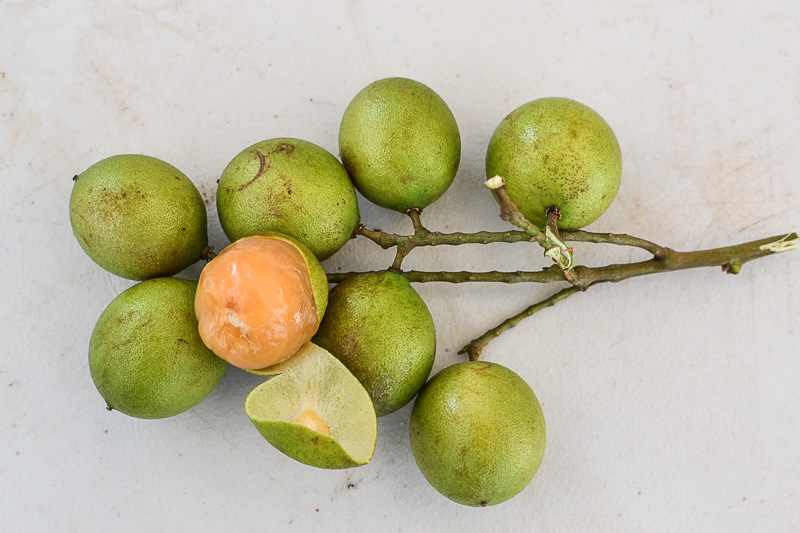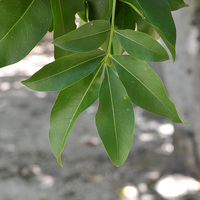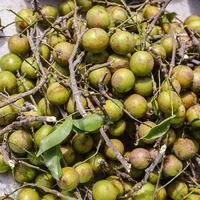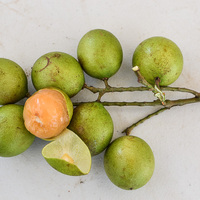Common name: Spanish Lime
Other common names: Ackee, Genip, Ginep, Guinep, Honey Berry
Description
Spanish Lime or Guinep is a Lychee (Litchi chinensis) relative originating in northern parts of South America and nowadays cultivated throughout tropical America and the Caribbean, including the Florida Keys at the southernmost tip of the United States.
It may grow to become a large tree reaching heights of up to 25 m (85 ft), sometimes with a fluted trunk, though on open sites, it is typically 9 to 18 m (30 to 60 ft) tall with a stout trunk, supporting a densely leafy rounded crown. The bark is grey and smooth.
Leaves are compound, consisting of four, occasionally six, dark green leaflets arranged in pairs along the length. They are briefly deciduous in areas with a pronounced dry season. Otherwise, they remain on the tree in all seasons and in a dense arrangement that casts a deep shade.
The flowers are small, green-white, and sweetly fragrant, with male and female flowers on separate trees. However, some trees also have bisexual or perfect flowers mixed in. They bloom from spring to summer, coinciding with the transition from the dry to the rainy season in its native range, borne in finger-like clusters at the ends of the branches.
Fertilised flowers develop into small round fruit in clusters resembling a bunch of giant green grapes and ripen from mid-summer to early autumn. They have thin, leathery green skin enclosing translucent, jelly-like orange pulp around a large seed, though some fruit may be double-seeded. Fruit size varies with the variety and growing conditions, ranging from 2 to 4 cm (0.75 to 1.5 in)in diameter.
Use
Spanish Lime is cultivated primarily for its fruit, though its attractive form, dense wide-spreading crown and shade are all appreciated in home gardens.
The fruit are mainly eaten fresh out of hand. The thin, leathery skin is first split using the teeth or fingernail, then peeled off to access the pulp, which is sucked away from the seed in the mouth. The jelly-like pulp has a pleasing sweet to slightly sour flavour, becoming astringent close to the seed. Care is taken not to swallow the large seed, which may present a choking risk, particularly in small children. It is usually spat out after the pulp is sucked away.
The flowers are a major bee forage and nectar source in Jamaica, Cuba, the Dominican Republic and Venezuela, with short but intense nectar flows from older trees. The pure honey is quite dark and acidic but with a pleasing flavour.
The wood is a pale yellow to pale brown, finely grained and of medium weight, averaging about 790 kilograms per cubic meter (49 lbs per cubic ft). It has low natural resistance to rot, decay and wood-boring insects, which places it in the non-durable hardwood class. Though not ordinarily available, the larger logs can be sawn to make furniture and cabinets. The smaller roundwood pieces are used for turnery and other woodcraft.

Climate
Spanish Lime flowers and fruits naturally in moderately humid tropical monsoon and savanna climates, generally frost-free areas with annual lows of 19 to 25°C, annual highs of 27 to 35°C, annual rainfall of 900 to 3000 mm and a dry season of 3 to 7 months. Trees may fail to flower or do poorly in areas where the average low of the coldest month is below 12°C (54°F).
Growing
New plants are commonly started from seed. However, seedling trees do not start to bear fruit until they are around ten years old. In contrast, vegetatively reproduced trees start fruiting after four to five years. Grafting cuttings of selected cultivars onto common seedling rootstock has given good results, as has air-layering (circumposing) techniques.
Vegetative reproduction is also the only way to know which plant is female and male, as both are needed for good pollination and fruit production.
Performs best on free-draining clay, loam and sand soils of a moderately acid to alkaline nature, generally with a pH of 5.5 to 8.0, and on sites with full to partial sun exposure. It has good tolerance to drought and limestone soils.
Problem features
Birds and bats disperse the seed in its native range, and it is listed as a weed in at least one reference publication. Still, there does not appear to be any record of it anywhere as a serious weed or invasive species.
The large oval seed presents a choking risk to young children, and some parents will request their child to chew the seed as a precaution while eating the fruit.
Where it grows
References
Books
-
Adams, C. D. 1972, Flowering plants of Jamaica, University of the West Indies, Mona, Greater Kingston
-
Bradbear, N. 2009, Bees and their role in forest livelihoods : a guide to the services provided by bees and the sustainable harvesting, processing and marketing of their products, Food and Agriculture Organization of the United Nations (FAO), Rome
-
Crane, E., Walker, P. & Day, R. 1984, Directory of important world honey sources, International Bee Research Association, London
-
Fawcett, W. 1891, Economic plants, An index to economic products of the vegetable kingdom in Jamaica, Jamaica Government Printing Establishment, Kingston
-
Francis, J. K. 1998, Tree species for planting in forest, rural, and urban areas of Puerto Rico, U.S. Department of Agriculture, Forest Service, International Institute of Tropical Forestry, Río Piedras, Puerto Rico
-
Francis, J. K. and Liogier, H. A. 1991, Naturalized exotic tree species in Puerto Rico, General technical report SO-82, USDA Forest Service, Southern Forest Experiment Station, New Orleans
-
Francis, J. K. et al. 2000, Silvics of Native and Exotic Trees of Puerto Rico and the Caribbean Islands, Technical Report IITF-15, USDA Forest Service, Rio Piedras, Puerto Rico
-
Gohl, B. 1981, Tropical Feeds : feed information summaries and nutritive values (Revised edition), Food and Agriculture Organization of the United Nations (FAO), Rome
-
Janick, J., & Paull, R. E. 2008, The encyclopedia of fruit & nuts, CABI Publishing, Wallingford, Oxfordshire
-
Kirk, T. K. 2009, Tropical trees of Florida and the Virgin Islands : a guide to identification, characteristics and uses, 1st ed, Pineapple Press, Sarasota, Florida
-
Morton, J. F. & Dowling, C. F. 1987, Fruits of warm climates, Creative Resources Systems, Winterville, North Carolina
-
Page, P. E. 1984, Tropical tree fruits for Australia, Queensland Department of Primary Industries (QLD DPI), Brisbane
-
Randall, R. P. 2002, A global compendium of weeds, R.G. and F.J. Richardson Press, Melbourne
Articles, Journals, Reports and Working Papers
-
Morton, J. F. 1976, Pestiferous spread of many ornamental and fruit species in south Florida. In Proceedings of the Florida State Horticultural Society (Vol. 89, pp. 348-353).
-
Watson, B.J., & Moncur, M. 1985, Guideline criteria for determining survival, commercial and best mean minimum July temperatures for various tropical fruit in Australia (Southern Hemisphere), Department of Primary Industries Queensland (DPI QLD), Wet Tropics Regional Publication, Queensland




